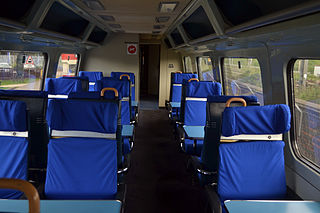This article needs additional citations for verification. (January 2024) |
| British Rail Class 370 Advanced Passenger Train – Prototype | |
|---|---|
 Class 370 at Carlisle | |
 First-class saloon in a preserved vehicle. (The plain blue seat covers are post-withdrawal replacements for the original tartan material.) | |
| In service | 1980–1986 |
| Manufacturer | British Rail Engineering Limited |
| Built at | Derby Works[1] |
| Family name | Advanced Passenger Train |
| Constructed | 1977–1980[2] |
| Entered service | 1979[3] |
| Number built | 3 full sets (6 units plus 2 spare vehicles)[3] |
| Number preserved | 7 vehicles |
| Formation | 7 cars per unit: DTS-TS-TRSB-TU-TF-TBF-M (full set is 2 units back-to-back) |
| Diagram |
|
| Fleet numbers | 370001–370006[3] |
| Operators | British Rail InterCity |
| Depots | Shields Road (Glasgow)[4] |
| Lines served | West Coast Main Line |
| Specifications | |
| Car body construction | |
| Train length | 147 m (482 ft)[5] |
| Car length |
|
| Width | 2.720 m (8 ft 11.1 in) |
| Height |
|
| Wheelbase |
|
| Maximum speed | 125 mph (200 km/h) |
| Weight |
|
| Traction motors | 4 × ASEA LJMA 410 F |
| Power output | 3,000 kW (4,000 hp) continuous |
| Electric system(s) | 25 kV 50 Hz AC overhead |
| Current collector(s) | Pantograph |
| UIC classification | 2′(2′)(2′)(2′)(2′)(2′)2′+Bo′Bo′ |
| Bogies |
|
| Minimum turning radius | 91 m (300 ft) |
| Braking system(s) | Hydraulic and hydrokinetic[6] |
| Safety system(s) | |
| Multiple working | Within class (max. 2 units) |
| Track gauge | 1,435 mm (4 ft 8+1⁄2 in) standard gauge |
| Notes/references | |
| Specifications given for seven-car units as at August 1981,[8] except where otherwise noted. A full set train would be formed of two units coupled back-to-back. | |
British Rail's Class 370 tilting trains, also referred to as APT-P (meaning Advanced Passenger Train Prototype), were the pre-production Advanced Passenger Train units. Unlike the earlier experimental gas-turbine APT-E unit, these units were powered by 25 kV AC overhead electrification and were used on the West Coast Main Line between London Euston and Glasgow Central. The train had eight traction motors fitted to the two central motor cars giving a total output of 8,000 hp (6,000 kW), which enabled it to set the UK rail speed record of 162.2 mph (261.0 km/h) in December 1979, a record that stood for 23 years until broken by a Eurostar Class 373 on the newly completed High Speed 1 line.[9]
- ^ "Advanced Passenger Train – Prototype". The Crewe Heritage Centre. Archived from the original on 24 June 2015. Retrieved 1 December 2015.
- ^ "BR, Class 370 Advanced Passenger Train Non-Driving Motor (NDM), 49004, Era 7". Hornby.com. Retrieved 24 February 2021.
- ^ a b c Marsden 1983, pp. 119–120
- ^ Coxon, Dave. "High speed pantograph testing in Scotland in October 1983". Testing Times. Retrieved 10 February 2023.
- ^ Boocock & Newman 1976, p. 660, Table 1.
- ^ British Rail's Advanced Passenger Train – InterCity APT (PDF). Derby: Chief Mechanical & Electrical Engineers' Department, British Railways Board. 1979. GM869/A10/1279. Retrieved 10 February 2023.
- ^ Tomorrow's train, today (PDF). London: British Railways Board. 1980. GM1000/A7/980. Retrieved 10 February 2023.
- ^ Vehicle Diagram Book No. 210 for Electric Multiple Units (including A.P.T.) (PDF). Derby: Mechanical & Electrical Engineering Department, British Railways Board. LC501, LE201, LH101, LH201, LH401, LJ101, LK201 (in work pp. 428–441). Archived from the original (PDF) on 21 January 2015. Retrieved 10 February 2023 – via Barrowmore MRG.
- ^ "Train smashes speed record". BBC News. 30 July 2003. Archived from the original on 27 April 2009. Retrieved 2 June 2010.
